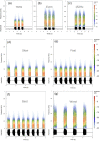Design of ideal vibrational signals for stinkbug male attraction through vibrotaxis experiments
- PMID: 34357680
- PMCID: PMC9292951
- DOI: 10.1002/ps.6590
Design of ideal vibrational signals for stinkbug male attraction through vibrotaxis experiments
Abstract
Background: Many groups of insects utilize substrate-borne vibrations for intraspecific communication. This characteristic makes them a suitable model for exploring the use of vibrations as a tool for pest control as an alternative to the use of chemicals. Detailed knowledge of species communication is a prerequisite to select the best signals to use. This study explored the use of substrate-borne vibrations for pest control of the brown marmorated stink bug (BMSB), Halyomorpha halys Stål (Heteroptera: Pentatomidae). For this purpose, we first identified the spectral and temporal characteristics that best elicit male responsiveness. Bioassays were conducted with artificial signals that mimicked the natural female calling signal. Second, we used the acquired knowledge to synthesize new signals endowed with different degrees of attractiveness in single- and two-choice bioassays using a wooden custom-made T stand.
Results: The results from this study showed that males were attracted to female signals along a high range of amplitudes, especially starting from a threshold of 100 μm s-1 , a high pulse repetition time (1 s) and frequency peak corresponding to the first harmonic (76 Hz). This resulted in an "optimal" signal for use to attract males, while the choice test in the T arena showed that this signal elicits searching behavior and attracts BMSB males towards a stimulation point.
Conclusion: We confirm the use of vibrational signals as a strong tool for behavioral manipulation of male BMSB and suggest its possible use in the development of field traps and further management of this pest. © 2021 The Authors. Pest Management Science published by John Wiley & Sons Ltd on behalf of Society of Chemical Industry.
Keywords: Halyomorpha halys; biotremology; brown marmorated stink bug; insects; playbacks; vibrational communication.
© 2021 The Authors. Pest Management Science published by John Wiley & Sons Ltd on behalf of Society of Chemical Industry.
Figures





References
-
- Foster SP and Harris MO, Behavioral manipulation methods for insect pest‐management. Annu Rev Entomol 42:123–146 (1997). - PubMed
-
- Baker BP, Green TA and Loker AJ, Biological control and integrated pest management in organic and conventional systems. Biol Control 140:104095 (2020).
-
- Götz B, Über weitere Versuche zur Bekämpfung der Traubenwickler mit Hilfe des Sexualduftstoffes. Anz Schädlingskd 15:109–114 (1939).
-
- Welter S, Pickel C, Millar J, Cave F, Van Steenwyk R and Dunley J, Pheromone mating disruption offers selective management options for key pests. Calif Agric 59:16–22 (2005).
-
- Koul O, Cuperus GW and Elliott N, Areawide Pest Management: Theory and Implementation. CABI, Wallingford: (2008).
MeSH terms
Grants and funding
LinkOut - more resources
Full Text Sources

